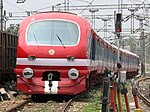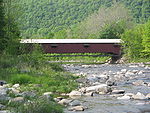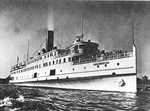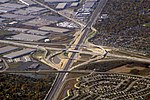| This page is currently inactive and is retained for historical reference. Either the page is no longer relevant or consensus on its purpose has become unclear. To revive discussion, seek broader input via a forum such as the village pump. |
This is an archive of article summaries that have appeared in the Selected article section of Portal:Transport in 2008. For past archives, see the complete archive page.
The Canadian Pacific Railway is a Canadian Class I railway operated by Canadian Pacific Railway Limited. Its rail network stretches from Vancouver to Montreal, and also serves major cities in the United States, including Minneapolis, Chicago, and New York City. Its headquarters are in Calgary, Alberta. The railway was originally built between eastern Canada and British Columbia between 1881 and 1885, fulfilling a promise extended to British Columbia when it entered Confederation in 1871. It was Canada's first transcontinental railway. Now primarily a freight railway, the CPR and its Canadian National Railway competitor were for many decades the only practical means of long distance passenger transport in many regions of Canada, and was instrumental in the settlement and development of western Canada. Its long-distance passenger services were transferred to VIA Rail Canada in 1978. The railway's logo, a beaver, was chosen because it is one of the national symbols of Canada and represents the hardworking character of the company. The object of both praise and damnation for over 120 years, the CPR remains an indisputable icon of Canadian nationalism.
Recently selected: - -
The Boeing 747, often referred to by the nickname "Jumbo Jet", is among the world's most recognizable aircraft, and was the first wide-body commercial airliner ever produced. Manufactured by Boeing's Commercial Airplane unit in the US, the original version of the 747 was two and a half times the size of the Boeing 707, one of the common large commercial aircraft of the 1960s. First flown commercially in 1970, it held the passenger capacity record for 37 years, until it was surpassed by the Airbus A380. The four-engine 747 uses a double deck configuration for part of its length. It is available in passenger, freighter and other versions. The 747's hump created by the upper deck allows for a front cargo door on freighter versions, and serves as additional seating in most versions. The 747-400, the latest version in service, is among the fastest airliners in service with a high-subsonic cruise speed of Mach 0.85 (567 mph or 913 km/h). It has an intercontinental range of 7,260 nautical miles (8,350 mi or 13,450 km). The 747-400 passenger version can accommodate 416 passengers in a typical three-class layout or 524 passengers in a typical two-class layout. The 747 was expected to become obsolete after 400 were sold because of the development of supersonic airliners, but it exceeded its critics' expectations with production passing the 1,000 mark in 1993. As of June 2008, 1,405 aircraft had been built, with 118 more in various configurations remaining on order. The latest version of the aircraft, the 747-8, is scheduled to enter service in 2009.
Recently selected: - -
A winter service vehicle (WSV), or snow removal vehicle, is used to clear thoroughfares of ice and snow. Winter service vehicles are usually based on dump truck chassis, with adaptations allowing them to carry specially designed snow removal equipment. Many authorities also use smaller vehicles on sidewalks, footpaths, and cycleways. Road maintenance agencies and contractors in temperate or polar areas often own several winter service vehicles, using them to keep the roads clear of snow and ice and safe for driving during winter. Airports use winter service vehicles to keep both aircraft surfaces, and runways and taxiways free of snow and ice, which, besides endangering aircraft takeoff and landing, can interfere with the aerodynamics of the craft. The earliest winter service vehicles were snow rollers, designed to maintain a smooth, even road surface for sleds, although horse-drawn snowploughs and gritting vehicles are recorded in use as early as 1862. The increase in motor car traffic and aviation in the early 20th century led to the development and popularisation of large motorised winter service vehicles.
Recently selected: - -
BC Rail (AAR reporting marks BCOL and BCIT), known as the British Columbia Railway between 1972 and 1984 and as the Pacific Great Eastern Railway (PGE; AAR reporting marks PGE and PGER) before 1972, was a railway that operated in the Canadian province of British Columbia between 1912 and 2004. It was a class II regional railway and the third-largest in Canada, operating 2 320 km (1,441 miles) of mainline track. It was owned by the provincial government from 1918 until 2004, when the operations were sold to the Canadian National Railway. The details of the sale have become the subject of protracted public inquiry as part of the proceedings of the trial surrounding a scandal known as the British Columbia Legislature Raids Affair, or "Railgate". Chartered in 1912, the railway was acquired by the provincial government in 1918 after running into financial difficulties. A railway that ran "from nowhere, to nowhere" for over 30 years, neither passing through any major city nor interchanging with any other railway, its southern terminus was at Squamish and its northern terminus at Clinton during that period. It expanded significantly between 1949 and 1984. Primarily a freight railway, it also offered passenger service, as well as some excursion services, most notably the Royal Hudson excursion train. The railway's operations were not always profitable, and its debts, at times, made it the center of political controversy.
Recently selected: - -
The Mini is a small automobile that was produced by the British Motor Corporation (BMC) and its successors from 1959 until 2000. The most popular British-made car ever, it was superseded by the New MINI, which was launched in April 2001. The original is considered an icon of the 1960s, and its space-saving front-wheel-drive layout (that allowed 80% of the area of the car's floorpan to be used for passengers and luggage) influenced a generation of car-makers. The vehicle is in some ways considered the British equivalent to its German contemporary, the Volkswagen Beetle, which enjoyed similar popularity in North America. This distinctive two-door car was designed for BMC by Sir Alec Issigonis. It was manufactured at the Longbridge and Cowley plants in the United Kingdom, the Victoria Park / Zetland British Motor Corporation (Australia) factory in Sydney Australia, and later also in Spain (Authi), Belgium, Chile, Italy, Portugal, South Africa, Uruguay, Venezuela and Yugoslavia. The Mini Mark I had three major UK updates: the Mark II, the Clubman and the Mark III. Within these was a series of variations including an estate car, a pickup truck, a van and the Mini Moke — a jeep-like buggy. The Mini Cooper and Cooper "S" were sportier versions that were successful as rally cars, winning the Monte Carlo Rally three times. Minis were marketed under the Austin and Morris names until Mini became a marque in its own right in 1969.
Recently selected: - -
New York State Route 28 (NY 28) is a state highway extending for 281.69 miles (453.34 km) in the shape of a "C" between the Hudson Valley city of Kingston and southern Warren County in the U.S. state of New York. Along the way, it intersects several major routes, including Interstate 88, U.S. Route 20, and the New York State Thruway twice. The southern terminus of NY 28 is at NY 32 in Kingston and the northern terminus is U.S. Route 9 in Warrensburg. In Kingston, NY 28 is also designated as Interstate 587 from its southern terminus at NY 32 to the roundabout linking it to the Thruway (I-87). NY 28 was originally assigned in 1924 to an alignment extending from Colliersville in the south to Utica in the north via Ilion. From Colliersville to Cooperstown, the highway followed its current routing (excluding minor realignments); north of Cooperstown, NY 28 was routed along several state highways that now have other designations. The route was extended south to Kingston and north to Warrensburg as part of the 1930 renumbering. At the same time, Route 28 was realigned between Cooperstown and Mohawk to follow its modern routing. Other than minor realignments in Kingston, Oneonta, and Oneida County, NY 28 has remained the same to this day.
Recently selected: - -
The London congestion charge is a fee for some motorists travelling within those parts of London designated as the Congestion Charge Zone (CCZ). The main objectives of this charge are to reduce congestion, and to raise funds for investment in London's transport system. The zone came into operation in parts of Central London on 17 February 2003 and it was extended into parts of west London on 19 February 2007. Although not the first scheme of its kind in the United Kingdom, it was the largest when it was introduced, and it remains one of the largest in the world. Worldwide, several cities have referenced the London scheme when considering their own possible schemes. A payment of £8 is required for each day a chargeable vehicle enters or travels within the zone between 7am and 6pm; a fine of between £60 and £180 is imposed for non-payment. The organisation responsible for the charge is Transport for London (TfL); Capita Group operates the scheme under contract. The system is run on a generally automatic basis using CCTV and Automatic Number Plate Recognition.
Recently selected: - -
- Week 36
- September 1-September 7
Indian Railways (Hindi: भारतीय रेल Bhāratīya Rel), abbreviated as IR (भारे), is a Department of the Government of India, under the Ministry of Railways, and is tasked with operating the rail network in India. The Ministry is headed by a cabinet rank Railways Minister, while the Department is managed by the Railway Board. Indian Railways is not a private corporate body; however, as of recently, IR has adopted a corporate management style. Indian Railways has a total state monopoly on India's rail transport. It is one of the largest and busiest rail networks in the world, transporting seventeen million passengers and more than two million tonnes of freight daily. IR is the world's largest commercial or utility employer, with more than 1.6 million employees. The railways traverse the length and breadth of the country; the routes cover a total length of more than 63,327 km (39,500 miles). As of 2008, IR owned about 225,000 wagons, 45,000 coaches and 8300 locomotives and ran more than 18,000 trains daily, including about 8,984 passenger trains and 9,387 goods trains. Railways were first introduced to India in 1853. By 1947, the year of India's independence, there were forty-two rail systems. In 1951 the systems were nationalized as one unit, becoming one of the largest networks in the world. Indian Railways operates both long distance and suburban rail systems.
Recently selected: - -
- Week 37
- September 8-September 14
American Airlines Flight 77 was the third flight hijacked as part of the September 11, 2001 attacks, and it was deliberately crashed into the Pentagon. The scheduled United States domestic flight from Washington Dulles International Airport, near Washington, D.C., to Los Angeles International Airport was hijacked by five individuals less than 35 minutes into the flight. The hijackers stormed the cockpit and forced the passengers to the rear of the aircraft. Hani Hanjour, one of the hijackers trained as a pilot, assumed control of the flight. Unknown to the hijackers, passengers aboard were able to make calls to loved ones and relay information on the hijacking. The aircraft crashed into the western facade of the Pentagon at 09:37 Eastern Time. All 64 people on board and 125 in the building were killed, including the hijackers. Dozens of people witnessed the crash and news sources began reporting on the incident within minutes. The impact severely damaged an area of the Pentagon and ignited a large fire. A portion of the Pentagon collapsed and firefighters spent days trying to fully extinguish the blaze. The damage to the Pentagon was later rebuilt and as of 2008, an outdoor memorial is being completed at the crash site.
Recently selected: - -
- Week 38
- September 15-September 21
The Forksville Covered Bridge is a Burr arch truss covered bridge over Loyalsock Creek in the borough of Forksville, Sullivan County, in the U.S. state of Pennsylvania. It is 152 feet 11 inches (46.61 m) in length, was built in 1850, and was placed on the National Register of Historic Places in 1980. The bridge is named for the borough it is in, which is named for its location at the confluence or "forks" of the Little Loyalsock and Loyalsock Creeks. Pennsylvania had the first covered bridge in the United States, and the most such bridges in both the 19th and 21st centuries. They were a transition between stone and metal bridges, with the roof and sides protecting the wooden structure from weather. The Forksville bridge is a Burr arch truss type, with a load-bearing arch sandwiching multiple vertical king posts, for strength and rigidity. The building of the Forksville bridge was supervised by the 18-year-old Sadler Rogers, who used his hand-carved model of the structure. It served as the site of a stream gauge from 1908 to 1913 and is still an official Pennsylvania state highway bridge. The United States Department of Transportation Federal Highway Administration uses it as the model of a covered bridge "classic gable roof", and it serves as the logo of a Pennsylvania insurance company.The bridge was restored in 1970 and 2004 and is still in use, with average daily traffic of 217 vehicles in 2006. Despite the restorations, as of 2006 the bridge structure's sufficiency rating on the National Bridge Inventory was only 17.4 percent and its condition was deemed "basically intolerable requiring high priority of corrective action". It is one of three remaining covered bridges in Sullivan County, and according to Susan M. Zacher's The Covered Bridges of Pennsylvania: A Guide, its location "over the rocky Loyalsock Creek" is "one of the most attractive settings in the state."
Recently selected: - -
- Week 39
- September 22-September 28
The Baltimore Steam Packet Company, also known as the Old Bay Line, was an American steamship line from 1840 to 1962, providing overnight steamboat service on the Chesapeake Bay, primarily between Baltimore, Maryland, and Norfolk, Virginia. Called a "packet" for the mail packets carried on government mail contracts, the term in the 19th century came to mean a steamer line operating on a regular, fixed daily schedule between two or more cities. By the time the venerable packet line ceased operation in 1962 after 122 years of existence, it was the last surviving overnight steamship passenger service in the United States. In addition to regularly calling on Baltimore and Norfolk, the Baltimore Steam Packet Company also provided freight, passenger and vehicle transport to Washington, D.C., Old Point Comfort, and Richmond, Virginia, at various times during its history. The Old Bay Line, as it came to be known by the 1860s, was acclaimed for its genteel service and fine dining, serving Chesapeake Bay specialties. Walter Lord, famed author of A Night to Remember and whose grandfather had been the packet line's president from 1893 to 1899, mused that its reputation for excellent service was attributable to "... some magical blending of the best in the North and the South, made possible by the Company's unique role in 'bridging' the two sections ... the North contributed its tradition of mechanical proficiency, making the ships so reliable; while the South contributed its gracious ease". One of the Old Bay Line's steamers, the former President Warfield, later became famous as the Exodus ship of book and movie fame, when Jewish refugees from war-torn Europe sailed aboard her in 1947 in an unsuccessful attempt to emigrate to Palestine.
Recently selected: - -
- Week 40
- September 29-October 5
Interstate 355 (I-355), also known as the Veterans Memorial Tollway, is an interstate highway and tollway in the western and southwest suburbs of Chicago, Illinois, U.S. Like other tollways in the northeastern portion of the state, I-355 is maintained by the Illinois State Toll Highway Authority (abbreviated ISTHA, but commonly referred to as the "tollway authority"). I-355 runs from Interstate 80 in New Lenox north to Interstate 290 in Itasca, a distance of 32.5 miles (52.3 km). The highway is six lanes wide for its entire length. The tollway authority opened I-355 as the North–South Tollway in 1989 to ease congestion on Illinois Route 53 (IL 53), a parallel two-lane state highway in central DuPage County. Initially, I-355 ran from Interstate 55 north to I-290. The new highway helped cut travel times for commuters traveling north and south in the county. According to commercial real estate developers at the time, the new tollway also opened the western suburbs of Chicago to commercial and industrial development. On November 11, 2007, the tollway authority opened a southern extension of I-355 from I-55 to I-80, a distance of 12.5 miles (20.1 km); on its opening, the tollway authority changed the name of the tollway to "Veterans Memorial Tollway". The tollway authority laid the route of the new extension through Will County and a small portion of Cook County, one of the fastest-growing regions in Illinois. The tollway authority expects the extension to cut travel times in the region by 20 percent.
Recently selected: - -
- Week 41
- October 6-October 12
Mass Rapid Transit or MRT is a rapid transit system that forms the backbone of the railway system in Singapore, spanning the entire city-state. The initial section of the MRT, between Yio Chu Kang and Toa Payoh, opened in 1987 establishing itself as the second-oldest metro system in Southeast Asia, after Manila's LRT System. The network has since grown rapidly as a result of Singapore's aim of developing a comprehensive rail network as the main backbone of the public transport system in Singapore with an average daily ridership of 1.564 million in FY07/08, about half of the bus network's 2.969 million in the same period. The MRT has 64 operating stations with 109.4 kilometres of lines and operates on standard gauge. The rail lines have been constructed by the Land Transport Authority, a department of the government of Singapore, which allocates operating concessions to the profit-based corporations SMRT Corporation and SBS Transit. These operators also run bus and taxi services, thus ensuring that there is a full integration of public transport services. The MRT is complemented by the regional Light Rapid Transit (LRT) systems that link MRT stations with HDB public housing estates. Services operate from about 5:30 am and usually end before 1 a.m. daily with frequencies of approximately three to eight minutes, and services extended during festive periods.
Recently selected: - -
- Week 42
- October 13-October 19
Portal:Transport/Selected article/Week 42, 2008
- Week 43
- October 20-October 26
Portal:Transport/Selected article/Week 43, 2008
- Week 44
- October 27-November 2
Portal:Transport/Selected article/Week 44, 2008
- Week 45
- November 3-November 9
Portal:Transport/Selected article/Week 45, 2008
- Week 46
- November 10-November 16
Portal:Transport/Selected article/Week 46, 2008
- Week 47
- November 17-November 23
Portal:Transport/Selected article/Week 47, 2008
- Week 48
- November 24-November 30
Portal:Transport/Selected article/Week 48, 2008
- Week 49
- November 31-December 7
Portal:Transport/Selected article/Week 49, 2008
- Week 50
- December 8-December 14
Portal:Transport/Selected article/Week 50, 2008
- Week 51
- December 15-December 21
Portal:Transport/Selected article/Week 51, 2008
- Week 52
- December 22-December 28
Portal:Transport/Selected article/Week 52, 2008
- Week 53
- December 29-January 4, 2009











